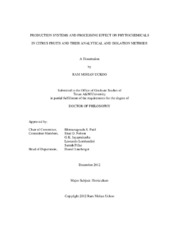| dc.description.abstract | The emerging scientific evidences on the role of food components in prevention of several chronic diseases are the momentum for shifting from a traditional focus on production to enhancement of nutritional quality. To further understand the role of these phytochemicals this dissertation describes the development of rapid analytical and isolation methods, and the effect of production systems and processing techniques on the levels of phytochemicals in citrus fruits.
In the first study, a simultaneous high performance liquid chromatography (HPLC) method for the rapid analysis of amines and organic acids was developed. The simultaneous extraction and analysis of samples provides an economical method for analyzing a large number of samples. In the second study, rapid separation method of potent health beneficial phytochemicals such as polymethoxyflavones from citrus peels using flash chromatography was developed. Using the developed method, five polymethoxyflavones were separated and isolated with high purity in gram level quantity. In the third study, the levels of phytochemicals in organically and conventionally grown lemons and their storage at market simulated conditions were determined. Results suggest that organically produced citrus fruits have higher content of organic acids and flavonoids than conventionally produced. The fourth and fifth study determined the influence of household processing (blending, juicing, hand squeezing techniques) and emerging processing (high pressure processing [HPP], thermal processing) on the phytochemicals content of ‘Rio Red’ grapefruits. Fruits processed by blending had significantly higher levels of flavonoids, furocoumarins and limonin compared to juicing and hand squeezing, while HPP enabled in extending the shelf life of the processed juice without any adverse effects. Therefore, consuming grapefruit juice processed by blending may provide higher levels of health beneficial phytochemicals. The sixth study describes a rapid flash chromatography method for isolation of PMFs and furocoumarins from citrus industrial by products such as peel oil. In the seventh study the developed method was applied to isolate 10 different phytochemicals from an unexplored citrus species, Miaray mandarin (Citrus miaray TAN.). Among them, the 5,7,8,3',4' pentamethoxyflavone was isolated for the first time from the genus Citrus. | en |


